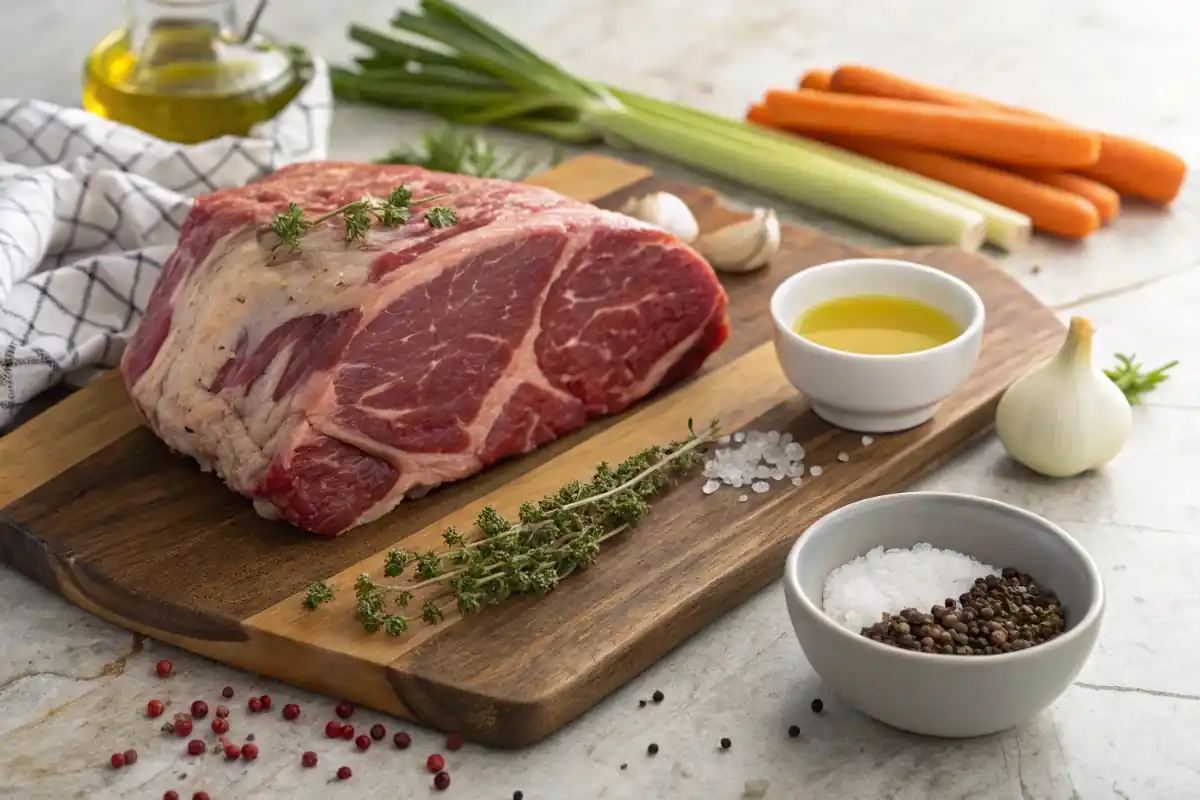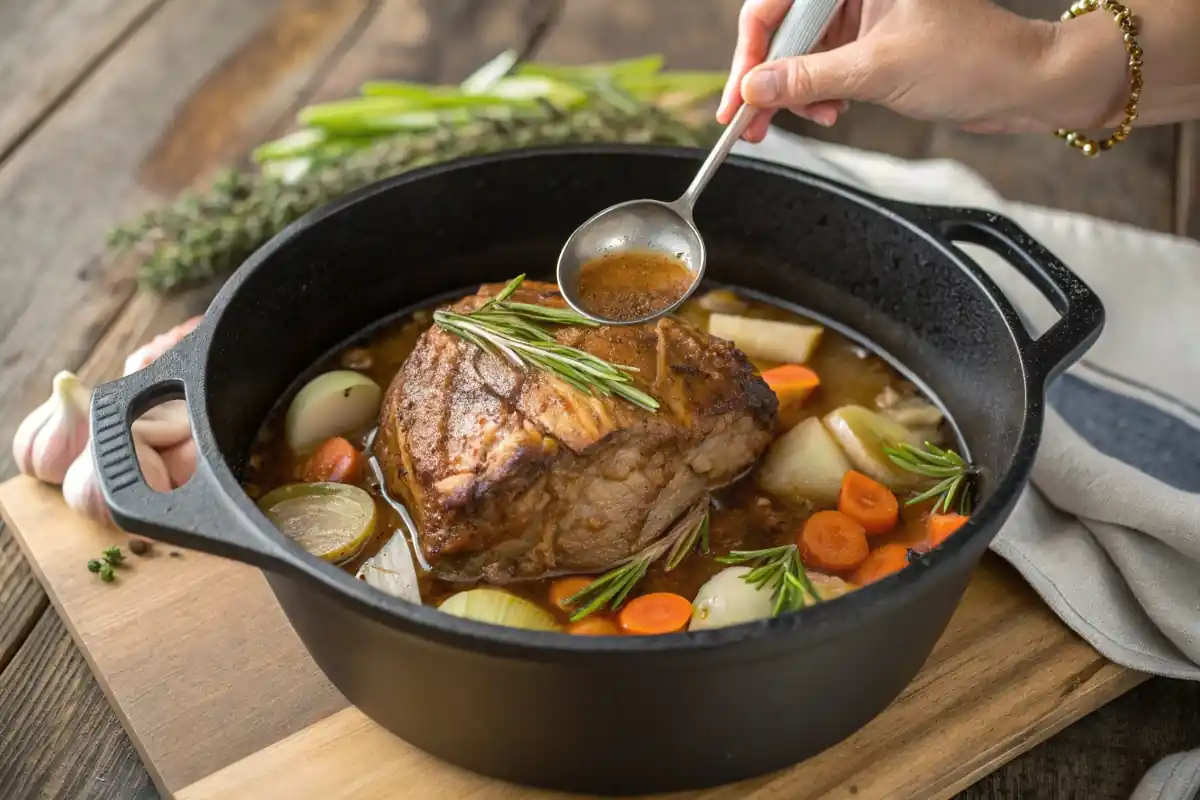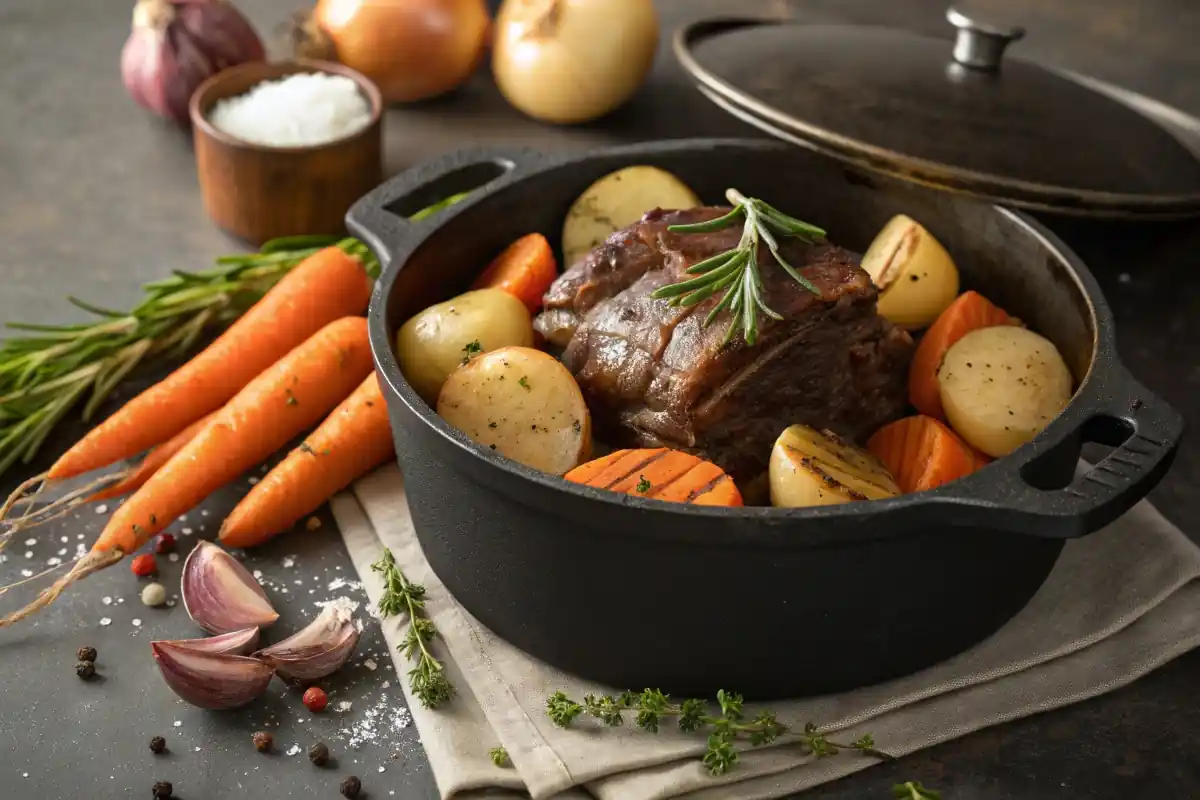Ready to make a beef shoulder roast that’s truly memorable? This guide will show you how. You’ll learn everything, from selecting the right cut to achieving perfect tenderness. Get ready for a satisfying meal!
What Makes a Beef Shoulder Roast Special?
The beef shoulder roast is a wonderful cut of meat. It’s known for its rich flavor and ability to become incredibly tender when cooked properly. Unlike leaner cuts, the shoulder has more connective tissue. This tissue breaks down during cooking. The result? A juicy, flavorful roast that’s perfect for family dinners. It’s also an affordable choice. This makes it an excellent option for feeding a crowd.
Different Names, Same Great Taste
You might hear the beef shoulder roast called by different names. “Chuck roast” is a very common alternative. Sometimes it’s also labeled as “pot roast.” These names refer to the same general area of the cow. So, don’t get confused by various labels. What matters is the cooking method and the final result. Whether you call it a beef shoulder roast or something else, prepare it with care!
Choosing the Right Beef Shoulder Roast
When buying a beef shoulder roast, look for good marbling. Marbling is the fat within the muscle. It adds flavor and moisture. A well-marbled roast will result in a more tender, delicious outcome. Check the color. It should be a bright red. This indicates freshness. Also, consider the size of the roast. Buy enough for your family, with maybe some extra for leftovers.

Ingredients:
- For the Roast:
- 3-4 pound beef shoulder roast (also called chuck roast or pot roast)
- 1 tablespoon olive oil (or any cooking oil with a high smoke point)
- 1 teaspoon salt (or to taste)
- 1 teaspoon black pepper (freshly ground is best)
- 1 teaspoon garlic powder
- 1 teaspoon onion powder
- 1 teaspoon smoked paprika (optional, for extra flavor)
- 1/2 teaspoon dried thyme (optional)
- 1/2 teaspoon dried rosemary (optional)
- 1/4 teaspoon red pepper flakes (optional, for a little heat)
- For Braising (if braising):
- 1 tablespoon olive oil (or any cooking oil with a high smoke point)
- 1 medium yellow onion, roughly chopped
- 2 carrots, peeled and roughly chopped
- 2 celery stalks, roughly chopped
- 2-3 cloves garlic, minced
- 2 cups beef broth (or beef stock)
- 1 cup red wine (optional, can substitute with more beef broth)
- 1-2 sprigs fresh thyme (optional)
- 1-2 sprigs fresh rosemary (optional)
- 1 bay leaf (optional)
- For Oven Roasting (if roasting):
- 1 tablespoon olive oil (or any cooking oil with a high smoke point)
- 1-2 pounds potatoes, cut into large chunks
- 2 carrots, peeled and cut into 2-inch pieces
- 1 large onion, cut into wedges
- For Gravy (Optional):
- Pan drippings from the roast
- 2 tablespoons all-purpose flour (or cornstarch for gluten-free)
- 2 cups beef broth (or water)
- Salt and pepper to taste

Expanded Step-by-Step Cooking Instructions:
Preparation (For Both Methods):
- Bring the Roast to Room Temperature: Take the beef shoulder roast out of the refrigerator about 30 minutes before you plan to cook. This helps it cook more evenly.
- Pat Dry: Use paper towels to pat the roast dry. This helps create a good sear.
- Season Generously: In a small bowl, mix the salt, black pepper, garlic powder, onion powder, smoked paprika (if using), dried thyme (if using), dried rosemary (if using), and red pepper flakes (if using). Sprinkle the mixture evenly all over the roast. Rub it in with your hands, making sure all surfaces are covered.
Instructions for Braising (Slow Cooker/Dutch Oven):
- Sear the Roast: Heat 1 tablespoon of olive oil in a large, heavy pot or Dutch oven over medium-high heat. Once the oil is hot (it will shimmer), carefully place the seasoned roast in the pot. Sear it on all sides until it is nicely browned. This takes about 2-3 minutes per side. Remove the roast from the pot and set aside.
- Sauté Vegetables: Add another tablespoon of olive oil to the same pot. Add the chopped onion, carrots, and celery. Cook, stirring occasionally, until the vegetables begin to soften (about 5-7 minutes). Then, add the minced garlic and cook for about 1 minute, until fragrant.
- Deglaze the Pot: Pour in the red wine (if using) and bring it to a simmer, scraping up any browned bits from the bottom of the pot. Let the wine reduce slightly, for about 2 minutes. This adds flavor.
- Add Broth and Aromatics: Pour in the beef broth. Add the fresh thyme sprigs (if using), rosemary sprigs (if using), and bay leaf (if using).
- Return the Roast: Gently place the seared roast back into the pot. The liquid should come about halfway up the sides of the roast. If it doesn’t add a little more broth.
- Bring to Simmer & Cover: Bring the liquid to a gentle simmer. Then, cover the pot tightly with a lid.
- Braise the Roast: Reduce the heat to low. Allow the roast to braise gently for 3-4 hours, or until it is very tender and easily pulls apart with a fork.
- Check for Doneness: The internal temperature, using a thermometer, should be between 195-205°F (90-96°C).
- Rest the Roast: Remove the pot from the heat. Transfer the beef shoulder roast to a cutting board. Cover it loosely with foil. Allow it to rest for 15-20 minutes before carving.
Instructions for Oven Roasting:
- Preheat the Oven: Preheat your oven to 325°F (160°C).
- Sear the Roast: Heat 1 tablespoon of olive oil in a large oven-safe pot or Dutch oven over medium-high heat. Sear the seasoned roast on all sides until it is nicely browned. Remove the roast from the pot and set aside.
- Add Vegetables: In the same pot, toss the potatoes, carrots, and onion wedges with a little olive oil, salt, and pepper. Arrange them in a single layer around the bottom of the pot.
- Return the Roast: Place the seared roast on top of the vegetables. Add about 1/2 cup of broth. This will ensure a little more moisture, and prevent the veggies from burning.
- Roast: Cover the pot tightly and place it in the preheated oven.
- Roast: Bake for about 3-4 hours, or until the roast is very tender and easily pulls apart with a fork. Check with a thermometer, the internal temperature should be between 195-205°F (90-96°C).
- Rest the Roast: Remove the pot from the oven. Transfer the beef shoulder roast to a cutting board. Cover it loosely with foil. Let it rest for 15-20 minutes before carving.
Making the Gravy (Optional):
- Skim Excess Fat: Carefully skim any excess fat from the top of the pan drippings in the pot.
- Make a Roux: Put the pot over medium heat. Add the flour and cook it, whisking constantly, for 1-2 minutes. This creates a roux (a thickener).
- Whisk in Broth: Slowly whisk in 2 cups of beef broth or water. Continue whisking until smooth.
- Simmer: Bring the gravy to a simmer, stirring occasionally, until it thickens to your desired consistency. This usually takes about 5-10 minutes.
- Season: Taste the gravy and season with salt and pepper as needed.
- Strain (Optional): If you prefer a smoother gravy, strain it through a fine-mesh sieve before serving.
Serving:
- Carve the Roast: After resting, carve the beef shoulder roast against the grain into slices or shred it.
- Serve: Serve the sliced or shredded roast with your choice of sides, and gravy (if made).
Tips for Success:
- Don’t rush the process: Low and slow cooking is key to tenderness.
- Use a meat thermometer: This is the best way to ensure the roast is cooked to the correct temperature.
- Rest the roast: This allows the juices to redistribute. The result will be a much more moist and flavorful roast.

Serving Your Perfectly Cooked Beef Shoulder Roast
Serving the beef shoulder roast can be an enjoyable experience. Carve it against the grain to make it even more tender. You can serve it with your favorite sides. Mashed potatoes, roasted vegetables, and gravy are fantastic choices. This creates a complete and satisfying meal. The rich flavors of the roast are particularly delightful.
Side Dish Suggestions
Mashed potatoes are a classic pairing for a beef shoulder roast. The creamy texture goes perfectly with the rich, flavorful meat. Roasted carrots, potatoes, and onions are also a great option. They can be cooked right alongside the roast for added convenience. You might also consider serving it with some crusty bread to soak up all the delicious juices. Basically, the options are endless.
Gravy Options for Your Roast
A good gravy is a must-have for many. You can use the pan drippings to make a rich and flavorful gravy. Specifically, skim off any excess fat from the pan drippings. Then, add a little flour to create a roux. Whisk in broth or water. Season with salt and pepper. Cook until the gravy thickens. This elevates the beef shoulder roast to a new level.
Leftover Ideas: Making the Most of Your Beef Shoulder Roast
Leftover beef shoulder roast is a gift! It can be used in so many delicious ways. Shredded beef tacos or sandwiches are a great option. Use it in a hearty stew or a flavorful chili. You can also use it to top salads or nachos. The possibilities are endless. Don’t let a single bit of this delicious meat go to waste.
Creative Leftover Recipes
Shredded beef shoulder roast is amazing in tacos. Add some salsa, cheese, and sour cream. You have a quick and tasty meal. You could use leftovers in a shepherd’s pie. Top the meat with mashed potatoes. Bake it until it’s bubbly and golden. A beef shoulder roast can also be chopped and added to a breakfast hash. This makes a hearty start to the day. These are just a few ideas to get you started. Ultimately, get creative and experiment with different flavor combinations.
Storing Leftovers
When you are done serving, store any leftover beef shoulder roast properly. Put it in an airtight container in the fridge. It can last for about 3 to 4 days. You can also freeze it for longer storage. Therefore, make sure it is cooled before you store it away. Freeze it in individual portions for easy use later on.
Tips for the Best Beef Shoulder Roast
- Always sear the roast well before cooking.
- Use low temperatures for slow cooking.
- Specifically, monitor the internal temperature with a meat thermometer.
- Rest the roast before carving. This will result in a much juicer roast.
- Don’t be shy with seasoning. Use the herbs and spices you enjoy.
- Use your leftovers wisely, and enjoy another meal the next day.

Addressing Common Issues
Sometimes, even with the best planning, things can go wrong. One common issue is a roast that is too dry. This usually means the roast was cooked at too high of a temperature. The solution? Reduce heat, and add some more liquid to the pot if necessary. Always keep a close eye while cooking to maintain the best level of moisture. This will help create the best result for your roast. Unquestionably, good cooking techniques will always result in the best dish.
Troubleshooting Tips
If your beef shoulder roast isn’t tender enough, it probably needs more time. Be sure to cook it slowly, and at a low temperature. A meat thermometer can be your best friend. This will help you keep track of the internal temperature. Also, consider braising, as this method does an excellent job of breaking down tough fibers. Moreover, when it comes to cooking the meat, patience will reward you with the best result.
Wrapping Up: Enjoy Your Delicious Roast
Cooking a beef shoulder roast can seem like a big task. However, with the right techniques and a little bit of patience, you can create an incredible meal. Whether you’re new to cooking or an experienced chef, there is nothing better than a perfectly made roast. Undoubtedly, the rich flavor and tender texture will impress anyone you share it with. So, go ahead, try these recipes, and enjoy every bite!
Why It’s Worth the Effort
The beef shoulder roast is an amazing choice. It is full of flavor and is often more affordable than other cuts. When cooked properly, the beef shoulder roast is tender, and satisfying. Finally, mastering the art of the perfect roast will always lead to a delicious, satisfying meal. This will furthermore allow you to improve your culinary skills. This will generally mean better meals for you and your family.
Final Thoughts
This recipe is a great way to enjoy a hearty meal. With simple techniques, you can create a wonderfully flavorful and tender beef shoulder roast. The versatility of this cut of meat means you can explore many options. So don’t hesitate to try different flavors and cooking methods. Eventually, you will find the combination that is perfect for you.
Frequently Asked Questions (FAQs):
What is a beef shoulder roast good for?
Beef shoulder roast is excellent for braising or slow cooking. It becomes incredibly tender and flavorful when cooked slowly. This makes it ideal for pot roast, shredded beef dishes, or hearty stews. The connective tissue breaks down as it cooks. This results in a rich and juicy meat that is perfect for a family meal.
Does shoulder roast get tender?
Yes, absolutely! Beef shoulder roast gets very tender when it’s cooked properly. The key is low and slow cooking. Braising or slow cooking in the oven will allow the connective tissue in the roast to break down. This creates a tender, pull-apart texture. The end result is a juicy, satisfying dish.
What is beef shoulder called in the UK?
In the UK, beef shoulder is often referred to as “braising steak” or “chuck steak.” These names refer to the same cut of meat. This part of the animal is known for its rich flavor and ability to become very tender with slow cooking. So, if you see these terms, know that they are similar to what we know as beef shoulder roast in the US.
How do I cook a beef roast without drying it out?
To avoid drying out a beef shoulder roast, use low and slow cooking methods. Searing the roast before cooking is essential. Make sure to cook it with liquid to prevent it from drying out. Cover the pot tightly during the cooking process. Avoid overcooking. Use a meat thermometer. This helps you monitor the internal temperature. Finally, be sure to let the roast rest before slicing. This helps keep all those juices intact.

